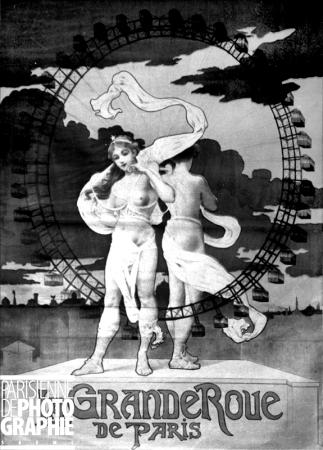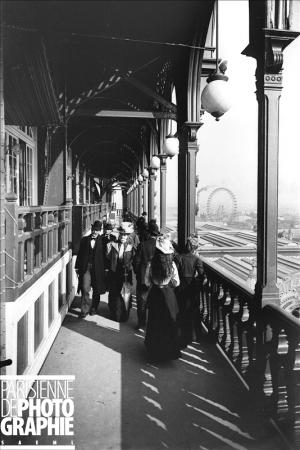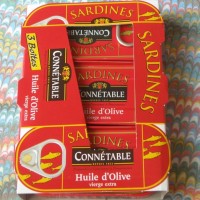It was an intriguing postcard, titled simply “Paris. La Grande Roue” (Paris, The Big Wheel). I didn’t recognize it, but I liked it, so I bought it. Little did I know that this purchase at an antiques fair in Paris would lead me to the Paris Gigantic Wheel and Varieties Company Limited and some unusual stories.
Can you imagine someone not recognizing the Eiffel Tower today? Well, in 1900 few in Paris could have imagined a future in which one would not recognize the Big Wheel. Ah, history and public memory can play such cruel tricks.
The back of the card is dated 10–12–18 (December 10, 1918, I gather) and contains a personal message from Jules to “ma cher petit [sic] femme” (my dear little wife). All we learn of the wheel is that Jules went up on it hoping to get a view of the Louvre from on high, but the day was too foggy. (You can see the message for yourself at the end of this post, if you are good at deciphering handwriting in French. And Jules had obviously failed dictée at school.)
Given the French leadership in artistic advertising, there is no shortage of images such as the one above. One is left with the impression that this great wheel is the centrepiece, the pride and joy of the 1900 Universal Exposition in Paris.
At 106 metres (over 300 feet), it was the tallest panoramic wheel to date and it would hold that record for more than eight decades, long after it had been torn down. Each of the 40 carriages carried 40 passengers and the arrangement of stairs and loading platforms was designed to allow passengers to get on or off 8 carriages at a time. With loading and unloading, each trip took 20 minutes. It was designed to transport 4,800 passengers an hour in cabins the size of railway carriages.
Much has been written about the wheel’s spectacular location in the exposition grounds dominated by the Eiffel Tower. Looking at a map or bird’s-eye view of the site, we can see that the Gigantic Wheel is actually relegated to a corner about as remote from the Eiffel Tower as possible, and its surroundings were a far cry from the carefully landscaped grounds of the Champs de Mars and the Eiffel grounds.
This is interesting, and suggests another question. Was the Gigantic Wheel hot news at the time or same old same old? Yes it was big, the biggest yet, but even when it opened, it was old hat. It traced its origins to another fair, at which an American engineer called George Washington Gale Ferris Jr. had an idea that would let the Columbian Exposition of 1893 in Chicago “out-Eiffel” Eiffel and his tower, which had opened four years earlier. His Ferris Wheel was huge and genuinely innovative. It was a big hit with the public, but a commercial disaster.
The Chicago Ferris Wheel sparked a series of imitations: first, at Earl’s Court in London (1895 for the India Empire Exhibition), then at Blackpool, a major tourist centre in northern England (1896), then Vienna (1897, to celebrate the 50th anniversary of the coronation of Austrian Emperor Franz Josef), and finally Paris (1899, in anticipation of the 1900 Exposition). And all these gigantic wheels were the creation of one man: Walter B. Basset, former British naval officer and hero, and managing director of the prestigious British engineering firm of Maudslay, Sons & Field. Much of the original engineering design was the work of a young engineer by the name of H. Cecil Booth.
Each grand or panoramic wheel used the same pattern of financing. Create a company and sell shares or debentures. The London company was The Gigantic Wheel and Recreational Towers Co. Limited, followed by The Blackpool Gigantic Wheel Co. Ltd., then the Vienna Gigantic Wheel (Wiener Riesen Rad) Ltd., and finally, the Paris Gigantic Wheel and Varieties Company Limited. This was formulaic entertainment, an investment in what I call the Technology of Tourism.
Somehow, the Paris Gigantic Wheel lacked the spirit of either innovation or bold design displayed by Eiffel in his 1889 Tower or by Ferris with his original wheel in Chicago in 1893. But the world was changing.
In an excellent book on the buildings and remains of Universal Expositions in Paris, Sur les traces des expositions universelles, Sylvain Ageorges calls the Exposition of 1900 a turning point. Earlier expositions, beginning with first at the Crystal Palace in London in 1851, were heavily didactic, perhaps too much so for many visitors.
But Paris 1900 was different. It was “plus joyeuse et populaire que les autres” (more playful and popular than the others, p. 110). In addition to the “grande roue de Chicago,” there were films by the pioneering Lumière brothers projected on giant screens 21 by 16 metres, and, at Le Phono Ciné Théatre, there were moving pictures synchronized to phonograph sounds.
The Grande Roue opened the year before the fair and was part of a larger area of restaurants, theatres, and other entertainments that was in full swing in 1899. It was at the southeastern edge of the more glamorous fair (where the avenue de Suffren is now) and seemed both far less imaginative and more relentlessly commercial. Today we might call it an entertainment district, like the tacky cluster of wax museums, cheap restaurants, casinos, and shops a stone’s throw from the majestic power of Niagara Falls.
The postcard above places the Big Wheel in what is called “le Wonderland.” Some accounts credit the creation and ownership of the Grande Roue to the French industrialist, Théodore Vienne, who had made his fortune in textiles and then turned to other pursuits, such as the Paris-Roubaix cycle race and boxing matches.
Vienne was a director and major shareholder in Basset’s Paris Gigantic Wheel and Varieties Company Limited. He appears to have been the force behind other attractions in the avenue de Suffren area, which was described as “un véritable kaleidoscope d’attractions.”
I don’t know when the area became known as “le Wonderland.” Perhaps it was in 1907, when Victor Breyer and Théodore Vienne opened the Wonderland Français Arena. This was the work of Vienne in his capacity as a boxing promoter. Some said he was none too scrupulous, but he did bring the big-name fighters to Paris.
One finds increasing criticism of Wonderland as an undesirable centre of music halls and boxing. Some said it was simply the changing tastes of the young 20th century. Whatever the reasons, the area’s reputation declined and it became seedier. This did not help traffic on the Gigantic Wheel. Its days were numbered; perhaps they had been so since its opening.
The photo above was taken in 1920 during the demolition of La Grande Roue. It didn’t even win a first in the demolition class: Earl’s Court operated for only 11 years and was torn down in 1907. However, perhaps La Grande Roue first showed us something that Blackpool would later confirm: a big wheel cannot win out over a grand tower.* Even though the view from the Gigantic Wheel was spectacular, it was a passive experience in which you sat, waited, and watched.
When the wheel was demolished, the spacious carriages were sent to northern France to serve as much-needed housing in an area where the ravages of war had taken its toll (according to Norman Anderson, Ferris Wheels: An Illustrated History, p. 110). One wonders if the shareholders who had bought into the Paris Gigantic Wheel and Varieties Company Limited to finance the wheel ever made any money.
So is the history of Grande Roue all over in Paris? Absolutely not. There is another. It has a stunning location near the Place de la Concorde and stays up for only part of the year. Some people would like it to stay all year. I hope not. Each year the opening and closing creates fresh excitement. The first Grande Roue ran out of excitement. Let us hope that doesn’t happen for the second Grande Roue de Paris.
Text by Norman Ball, with illustrations from his postcard collection, and from the Roger Viollet collection, Paris en Images.
* Blackpool learned its lesson early on. The wheel opened in 1896, but in 1916 the Blackpool Gigantic Wheel Co. Ltd. went into voluntary liquidation. The new owners hung on until 1928 when they closed it, and sold off the carriages to people who converted them into storage sheds, living accommodations and even a café. When the Blackpool wheel opened, residents wondered if it would take business away from the popular tower. It didn’t.





























Strangely enough, I bought a similar postcard at a fair recently of the same wheel, with the intention of looking a bit further into the subject. I now don’t need to though as you have done an excellent job here! Thanks!
I am glad I was able to help Adam. It was a fun piece to research but not the easiest. You seem to have an endless supply of good things to write about and I always read and enjoy Invisible Paris as soon as it comes in.
Enjoy so much your “history’ stories…and the photos that go along with them……in fact,I
enjoy all that you write about….thank you!
Delighted you enjoy the history stories. I like hunting them up and comments from readers makes it even more worthwhile.
Between you and Adam you get a perfect mix of interesting, fascinating and ‘good-to-know’ items for us to peruse, digest and mostly simply enjoy tremendously! Being a ‘stranger’ to Paris myself, I already often learned about puzzling interesting stuff I encountered – and thus got answers to thanks to Adam and you!
Thank you – stunning old postcards
Thanks so much for your kind observations. Glad you enjoy it and I’ll keep trying to keep you smiling. I do have a few postcards that I’ll be calling on soon.
It makes the London Eye seem very unoriginal indeed! Loved this post and the history behind the postcard you found.
I guess it might look a bit unoriginal. However, there are only so many new ideas. My problem with the London Eye is nerve, or lack thereof to go up on it. I know it is irrational; I love flying, particularly landing and taking off, but I have a bit of a fear of some heights. One day. I understand the view is fabulous.
Now if only the London Eye would disappear the same way…
Pingback: Dateline Paris 1900: The Astounding Moving Electrical Sidewalk | Parisian Fields
Pingback: Connaissez-vous Paris? | Parisian Fields
Pingback: Food, drink, and lodging in Paris postcards | Parisian Fields
Pingback: The Other Great Nineteenth-Century Tower of Paris | Parisian Fields
Pingback: The Paris Blog: Paris, France Expat Tips & Resources »Blog Archive » The Other Great Tower
HC Booth , my Great Grandfather was as you say the chief designer and consulting engineer , I have here the original calculations and drawings for this wheel . The company name on the drawings is W B Basset , Engineer and Contractor . Hubert Cecil Booth was also involved as designer I believe in the Great Wheel , Vienna . He later went on to invent the Vaccum cleaner .
I found your very interesting article after researching an item I recently purchased from a Parisian antiques seller. It is a brass treadplate similar to those found when entering a railway carriage and indeed the seller was under the impression that it was just that. However the plate carries the wording “W.B. Basset 1898 London”. It’s about 73cm by 13 cm and must weigh about 3-4 kilos. No doubt it’s an original item, and I think must originate from the Grande Roue de Paris, possibly from one of the 40 carriages. I don’t seem to be able to post a photo here, but you are welcome to use a photo if it’s of interest.
Yes, it is of interest. Do send the photo to parisianfields@gmail.com so we can take a look. Which Parisian antiques seller was it? Or was it one of those pop-up brocante fairs that we enjoy so much?